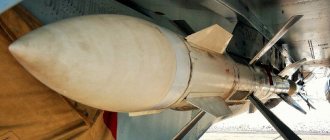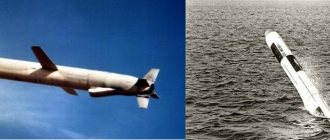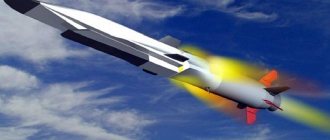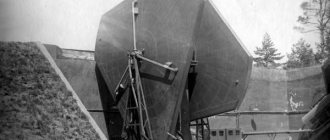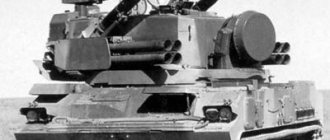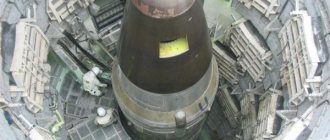Strategic missile system "Topol-M"
• The RT-2PM2 "Topol-M" complex (code RS-12M2, according to NATO classification - SS-27 Sickle "Sickle") - a Russian strategic missile system with an intercontinental ballistic missile, developed in the late 1980s - early 1990s years on the basis of the RT-2PM "Topol" complex.
• The first intercontinental ballistic missile developed in Russia after the collapse of the USSR. Adopted into service in 1997. The lead developer of the missile system is the Moscow Institute of Thermal Engineering (MIT).
• The rocket of the Topol-M complex is solid-fuel, three-stage. The maximum range is 11,000 km. Carries one thermonuclear warhead with a power of 550 kt. The missile is based both in silo launchers (silos) and on mobile launchers. The silo-based version was put into service in 2000.
• The Topol-M stationary complex includes 10 intercontinental ballistic missiles mounted in silo launchers, as well as a command post. Main characteristics:
Number of stages - 3 Length (with main engine) - 22.55 m Length (without main engine) - 17.5 m Diameter - 1.81 m Launch weight - 46.5 t Throwing weight 1.2 t Type of fuel - solid mixed Maximum range — 11,000 km Type of warhead — monoblock, nuclear, detachable Number of warheads — 1 + about 20 dummies Charge power — 550 Kt Control system — autonomous, inertial on the basis of the on-board central heating system Mounting method — silo and mobile
• The Topol-M mobile complex consists of one missile placed in a high-strength fiberglass transport and launch container (TPK), mounted on an eight-axle MZKT-79221 cross-country chassis and is structurally practically no different from the silo version. The weight of the launcher is 120 tons. Six pairs of eight wheels are swivel, providing a turning radius of 18 meters.
• The ground pressure of the installation is half that of a conventional truck. Engine V-shaped 12-cylinder turbocharged diesel engine YaMZ-847 with a power of 800 hp. The depth of the ford is up to 1.1 meters.
Arbovyaz Topol-M TM KROK
The Topol-M safety belt system is a universal safety harness for arboristry with increased comfort with the ability to install two breeches and an advanced equipment hanging system. Being extremely versatile and customizable, the system is perfect for both SRT and DdRT vehicles.
The Topol-M harness is equipped with a wide waist corset and leg wraps made of durable polyamide fabric with PVC impregnation, which gives the corset rigidity and increased wear resistance. The power frame of the harness is made of spaced polyamide tapes 30 mm wide, which evenly distribute the load over the entire surface of the corset and legs. For maximum comfort when working on wood for long periods of time, the system is equipped with a soft 15 mm thick foam pad. The construction of the adjacent side of the lining from a three-dimensional mesh, in combination with ventilation channels in the soft lining, provides ventilation.
Shoulder straps with a soft half-vest securely hold the harness at the arborist's waist and effectively distribute the weight of equipment (petrol tools) suspended from the harness. The X-shaped arrangement of the shoulder straps gives maximum freedom when tilting the body and removes maximum weight from the chairs installed in reinforced slots.
Double duralumin rings, used instead of D-rings, always optimally redistribute load vectors in the system of arbo-tethering tape slings and prevent the occurrence of their dangerous kinks, leading to abrasions and premature destruction of textiles. The size and orientation of the rings make it extremely convenient to hit them with a snap hook. The minimum tensile strength of the large ring is 22 kN.
The bridge rings are also made of duralumin with a minimum strength of 22 kN. And the presence of additional holes in them significantly expands the functionality of the system. It is possible to install one or two rope breeches, attaching a wrap or crawl bridge to the rings.
The position of the bridge rings relative to the arborist's body is fully adjustable. The presence of adjustable consoles to the belt and leg crossbars allows you to set the rings higher or lower, position them closer or further from the worker’s body. Crossbars additionally increase mobility when turning the body, due to sliding through special grooves in the rings. In this case, the leg girdle is additionally fixed on the leg with fastex.
The option of attaching the harness to the bridge rings distributes the load between the belt and the leg grips, which increases the comfort of working in the Topol-M arbor harness, and, more importantly, reduces the likelihood of getting a lower back injury when falling onto a low-mounted harness.
Using a rope with a diameter of 10–12 mm as a bridge makes it possible to quickly replace a worn or damaged bridge even in the field and further reduces the cost of operating the system. In addition, the rope bridge can be easily adjusted to the desired length using a reef knot.
A “crawl” can be installed in an additional pair of holes on the bridge rings. In this case, there is no need for specially shaped carabiners, such as “Omni”; any oval with a coupling is suitable for attaching the clamp. In this case, the crawl is located almost at the same level as in speleosystems, and allows you to organize a quick and efficient rise to the working area from the ground.
The belt and leg loops of the Topol-M system are equipped with second-generation Cobra quick-release buckles. This allows you to comfortably remove and put on the system in just a few seconds. Also, the new buckles do not float under varying loads.
The Topol-M corset has four unloading loops in a protective shell and a soft auxiliary loop, which also serves as a handle for convenient transportation of the system with hanging equipment. The belt is equipped with two reinforced slots for CARITOOL hanging carabiners for hanging gas-powered tools, and four additional slots that allow you to conveniently organize equipment.
Additionally, on the shoulder straps there is a strap for attaching the radio to a clip and a soft Velcro part for a chevron, a hemostatic tourniquet or a quick-release mount for additional equipment. Metal rings on the shoulder girdles serve to fasten the crawl stretching tape, and in the absence of the latter, they can be used as additional cargo shelves.
Also, additional slots and metal rings are located on the leg arms.
The Topol-M system is available in two sizes. It is possible to produce a harness of a different size upon request.
| Marking | Waist size, cm | Thigh volume, cm |
| S-ML | 70–100 | 45–70 |
| L-XL | 95–125 | 55–80 |
Intercontinental ballistic missile Topol (RS-12M)
The missile is designed according to a design with three sustainer and combat stages. To ensure high energy-mass perfection and increase the firing range, a new high-density fuel with a specific impulse increased by several units was used in all sustainer stages compared to the fillers of previously created engines, and the housings of the upper stages were for the first time made of continuous winding from organoplastic according to the “cocoon” pattern " The most difficult technical task turned out to be the placement on the front bottom of the body of the upper stage of the thrust cut-off unit with eight reversible bells and “windows”, cut through by detonating elongated charges (DUS - detonating elongated charge) in an organoplastic power structure.
The first stage of the rocket consists of a sustainer solid propellant rocket engine and a tail section, on the outer surface of which aerodynamic rudders and stabilizers are located. The main engine has one fixed nozzle. The second stage structurally consists of a connecting compartment and a main solid propellant rocket engine. The third stage has almost the same design, but it additionally includes a transition compartment to which the head part is attached.
An autonomous, inertial control system was developed at NPO Automation and Instrumentation under the leadership of Vladimir Lapygin. The aiming system was developed under the leadership of Kievsky chief designer Seraphim Parnyakov. The inertial control system has its own digital computer, which made it possible to achieve high shooting accuracy. According to domestic sources, the circular probable deviation (CPD) when firing at the maximum range is 400m, according to Western sources - 150-200m. The control system provides missile flight control, routine maintenance on the missile and launcher, pre-launch preparation and launch of the missile without turning the launcher. All pre-launch preparation and launch operations are fully automated.
"Topol" is equipped with a set of means to overcome missile defense. The rocket's flight is controlled by rotary gas-jet and lattice aerodynamic rudders. New nozzle devices for solid fuel engines have been created. To ensure secrecy, camouflage, decoy systems, and camouflage means have been developed. Like previous mobile complexes of the Moscow Institute of Thermal Engineering, Topol can be launched both from a combat patrol route and while parked in garage shelters with a retractable roof. To do this, the launcher is hung on jacks. Combat readiness from the moment the order was received until the missile was launched was brought to two minutes. Mobile and stationary command posts were developed for the new complexes. The mobile command post for combat control of the Topol ICBM is located on the basis of a four-axle MAZ-543M vehicle. To control the fire, mobile command posts “Barrier” and “Granit” were also used, equipped with a missile, with a transmitter instead of a combat load, which, after launching the missile, duplicated the start command for the launchers located in the position areas.
During operation, the missile is located in a transport and launch container installed on a mobile launcher. It is mounted on the basis of a seven-axle chassis of a MAZ heavy-duty vehicle. The rocket is launched from a vertical position using a powder pressure accumulator placed in a transport and launch container.
Launcher (see
) was developed at the Volgograd Central Design Bureau "Titan" under the leadership of Valerian Sobolev and Viktor Shurygin. The launcher is mounted on the chassis of a seven-axle tractor MAZ-7912 (later - MAZ-7917 with a 14x12 wheel arrangement. This machine from the 80s is equipped with a 710 hp diesel engine) from the Minsk Automobile Plant with an engine from the Yaroslavl Motor Plant. Chief designer of the rocket carrier Vladimir Tsvyalev. Solid propellant engine charges were developed at the Lyubertsy NPO Soyuz under the leadership of Boris Zhukov (later the association was headed by Zinovy Pak). Composite materials and the container were developed and manufactured at the Central Research Institute of Special Engineering under the leadership of Viktor Protasov. The steering hydraulic drives of the rocket and the hydraulic drives of the self-propelled launcher were developed at the Moscow Central Research Institute of Automation and Hydraulics. The nuclear warhead was created at the All-Union Research Institute of Experimental Physics under the leadership of chief designer Samvel Kocharyants.
Initially, the warranty period for the rocket's operation was set at 10 years. Later the warranty period was extended to 15 years. The mobile command post for combat control of the Topol ICBM was located on the chassis of a four-axle MAZ-543M vehicle. To control the fire, mobile command posts “Barrier” and “Granit” were also used, equipped with a missile, with a transmitter instead of a combat load, which, after launching the missile, duplicated the start command for the launchers located in the position areas.
LiveInternetLiveInternet
RS-12M "Topol" 15Zh58 RT-2PM SS-25 "Sickle"
One of the most successful modern Russian complexes is considered to be the Topol mobile ground missile system (SS-25 “Sickle” according to NATO classification) with the RS-12M missile.
The development of the intercontinental ballistic three-stage missile RT-2PM on solid mixed fuel weighing 45 tons with a monoblock nuclear warhead (weight 1 ton) was carried out by the Moscow Institute of Thermal Engineering under the leadership of chief designer Nadiradze (after his death the development was continued by Lagutin) and is a further modernization of the RT-2P missile.
The first flight test of the missile was carried out at the Plesetsk test site on February 8, 1983, and in 1985 the RT-2PM missile entered service with the Strategic Missile Forces. The RT-2PM missile is produced in Votkinsk, its launcher - a seven-axle vehicle of the MAZ-7310 type (later modifications to the MAZ-7917) - in Volgograd. The RT-2PM missile spends its entire service life in a sealed transport and launch container 22 m long and 2 m in diameter. The launcher weighs about 100 tons. and a very respectable size, it has good mobility and cross-country ability.
Unlike the RSD-10 and Temp-2S, the Topol complex missile can be launched from any point on the combat patrol route. If necessary, the RS-12M can be launched directly from hangar 15U135 “Krona” during parking, through the sliding roof. To launch from an unequipped position, the launcher is hung on jacks and leveled. Preparation time for the start is about 2 minutes. The type of launch is mortar: after installing the “pencil case” in a vertical position and shooting off its upper cap, the powder pressure accumulators push the rocket out of it to a height of several meters, after which the first stage propulsion engine is started.
The RT-2PM missile is designed according to a design with three sustainer stages. The rocket used a new, more advanced mixed fuel developed at the Lyubertsy LNPO Soyuz. All three stages are equipped with solid propellant rocket engines with one fixed nozzle. On the body of the first stage there were folding rotary lattice aerodynamic rudders (4 pieces), used for flight control together with gas-jet rudders and 4 lattice aerodynamic stabilizers. The bodies of the upper stages were manufactured using the method of continuous winding from organoplastic according to the “cocoon” pattern. The third stage was equipped with a transition compartment for attaching the warhead. The firing range was controlled by cutting off the third-stage propulsion engine, using a thrust cut-off unit, with eight reversible bells and “windows” cut through by detonating charges in the organoplastic power structure of the body.
The guidance system is autonomous, inertial with an on-board computer. The warhead is monoblock, nuclear, weighing about 1 ton. The missile was equipped with a set of means to overcome the missile defense of a potential enemy. The integrated control system made it possible to fully automate the control of the rocket in flight, preparation for launch and carrying out control and regulatory work.
After modernization, the missile could be used in a silo.
The starting batteries are controlled by PKP "Zenit" (divisional link) and "Granit" (regimental link). The mobile command post for combat control of the Topol ICBM was located on the chassis of a four-axle MAZ-543M vehicle. For fire control, mobile Barrier command posts were also used, equipped with a missile, with a transmitter instead of a combat load, which, after launching the missile, duplicated the launch command for the launchers located in positional areas.
In 1984, the construction of stationary structures and the equipment of combat patrol routes for Topol mobile missile systems began in the positional areas of the RT-2P and UR-100 ICBMs being removed from duty and located in the OS silos. Later, the positioning areas of medium-range complexes removed from service under the INF Treaty were arranged.
The Topol complex began entering service in 1985. The first missile regiment went on combat duty near Yoshkar-Ola on July 23, 1985. The Topol missile divisions were deployed near the cities of Barnaul, Verkhnyaya Salda (Nizhny Tagil), Vypolzovo (Bologoe), Yoshkar-Ola, Teykovo, Yurya, Novosibirsk, Kansk, Irkutsk, as well as near the village of Drovyanaya, Chita region. Nine regiments (81 launchers) were deployed in missile divisions on the territory of Belarus - near the cities of Lida, Mozyr and Postavy. After the collapse of the USSR, some of the Topols remained on the territory of Belarus and were withdrawn from it by November 27, 1996.
According to the START-2 treaty, 360 units of the Topol missile system will be reduced by 2007.
In 1986, on the basis of the second and third stages of the RT-2PM rocket, a medium-range mobile soil complex “Speed” was developed.
On the basis of the Topol ICBM, a conversion space launch vehicle "Start" was developed. Start rockets are launched from the Plesetsk and Svobodny cosmodromes.
An interesting fact is that the Topol complex is the first Soviet strategic missile system, the name of which was declassified in the Soviet press in an article refuting accusations from the American side that Russia was allegedly testing a new missile system in violation of the current arms reduction treaty .
| Tactical and technical characteristics of the Topol complex | |
| Firing range, km | 10000 |
| Number of steps | 3 |
| Launch weight, t | 46 |
| Length, m | 18,5 |
| Case diameter, m | 1,8 |
| Head part | monobloc detachable |
| Head weight, kg | 1000 |
| Nuclear power | 0,55 |
| Firing accuracy (CAO), m | 900/200* |
| Control system | inertial, onboard computer |
| Launcher | 7-axle chassis MAZ-7310 |
| Preparation time for launch, min | 2 |
| * - according to Russian/foreign sources | |
Solid fuel boiler ZOTA Topol-M 80
The Topol-M series of solid fuel boilers is represented by models with a power from 14 to 80 kW, which makes these compact boilers suitable not only for houses and cottages, but also for industrial premises.
The Topol-M housing is designed to maximize heat transfer, extend the burning time with one load to 12 hours and reduce heat loss during boiler operation:
- •Increased gas density;
- •A heat-insulating layer of basalt cardboard is hidden under the casing;
- •Lockable horizontal combustion door;
- •Precise adjustment of oxygen supply (when installing a draft regulator);
- •Additional horizontal heat exchanger;
There is a thermometer in the upper part of the boiler to monitor temperature parameters, and a removable damper and cleaning hatch allow you to easily remove soot and clean the heat exchanger and flue. The boiler also has a separate ash door, which allows you to remove soot even while the boiler is firing.
Topol-M boilers use coal and wood as fuel, however, all models can also be equipped with a heating element unit and a gas burner, which allows the use of gas or electricity as an alternative fuel. The boiler body already has compartments for installing heating elements and a temperature sensor.
Feature of the Topol-M series
- •Convenient loading chamber. The front combustion chamber is designed for efficient combustion of a sufficient amount of coal and firewood.
- •Ability to operate on any fuel. In the standard version, all boilers operate on wood and coal, however, each boiler can be equipped with a heating element unit, with which the boiler will operate using electricity. It is also possible to use gas as fuel when installing a gas burner.
- •High efficiency. Models in this series have the highest efficiency among budget models due to their design.
Advantages of solid fuel boilers of the ZOTA “Topol-M” series
- •the boiler body has become thermally insulated and more gas-tight. The water jacket of the boiler under the decorative casing is now covered with basalt cardboard, which has significantly reduced heat loss. The fire door opens in a horizontal rather than vertical plane and is locked with a lock. The ash pan door is equipped with a blower damper, which is adjusted manually using a screw or controlled by a mechanical draft regulator, which is installed as an option. Thus, the increased gas density of the boiler makes it possible to more accurately regulate the oxygen supply and extend the fuel combustion cycle on one load to 10-12 hours.
- •the combustion chamber has undergone changes: an additional horizontally located heat exchanger in combination with a removable damper makes the gas duct three-pass. This increases the heat transfer area and improves heat transfer efficiency. The damper is made removable specifically for cleaning the heat exchanger. In addition, there is a cleaning hatch on the flue, which makes it easy to remove soot.
- •a thermometer is installed on the top panel of the boiler to measure the temperature of the water supply.
- •Topol M uses coal and wood as fuel. As an alternative, electric heating is possible, which is provided by a built-in heating element with an external control panel (installed upon request and is an option). It is also possible to install a gas burner in place of the screw door. In addition, the presence of a screw door creates additional convenience for loading firewood into the firebox. The depth of the firebox ranges from 38 to 58 cm. A separate ash door allows you to remove ash at any time while the boiler is firing. For user convenience, new ergonomic handles are installed on all three doors.
- •due to the design features of the fuel combustion chamber, increased gas density and workmanship, the Topol M series of boilers has the highest efficiency among budget models of solid fuel and combined boilers.
- •possibility of additional installation of the “TENB 2″” kit.
The solid fuel heating boiler "Topol M" is a modification of the boiler "Topol". It is designed to work in autonomous heating systems with a working pressure of up to 3 atmospheres and can be used for heating residential and industrial premises.
